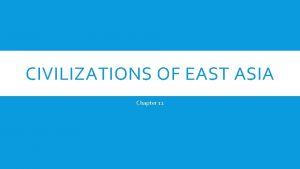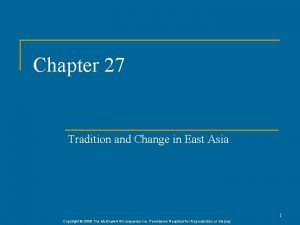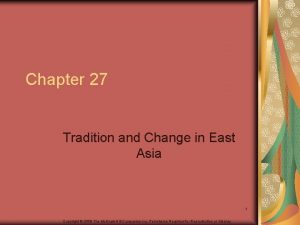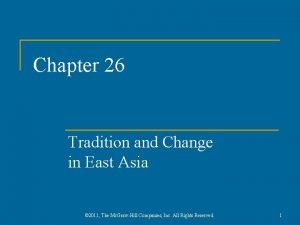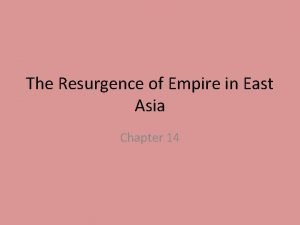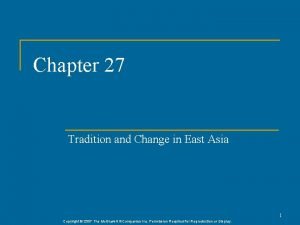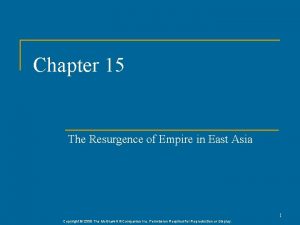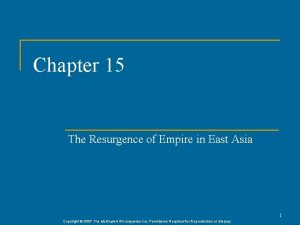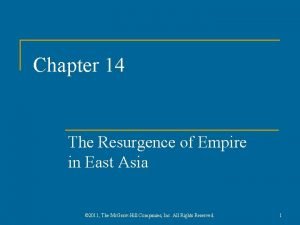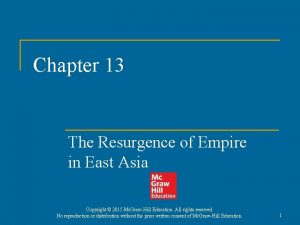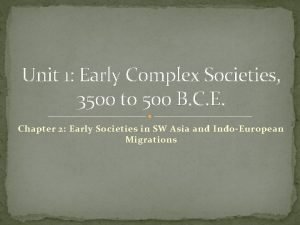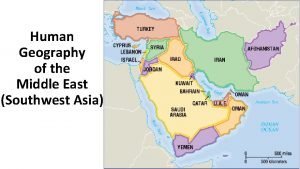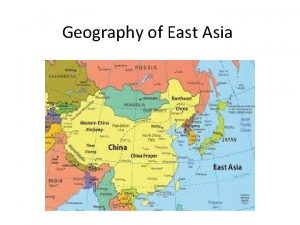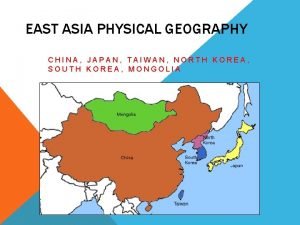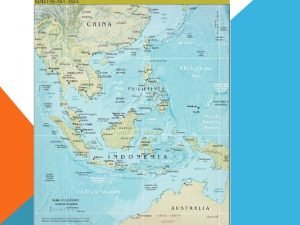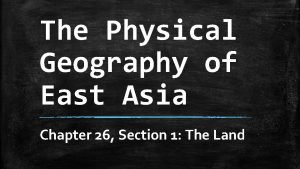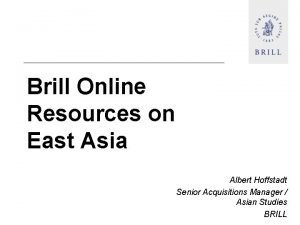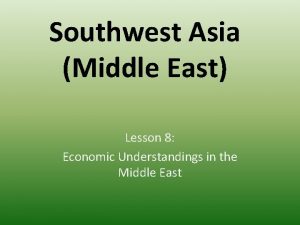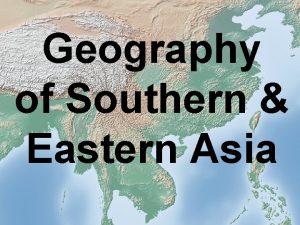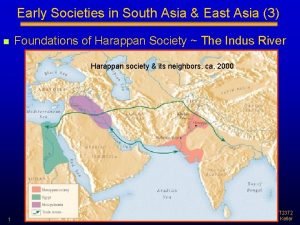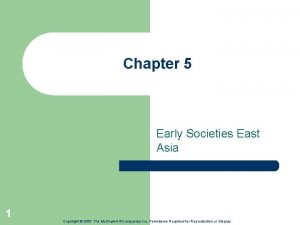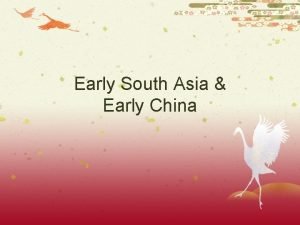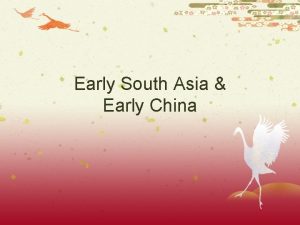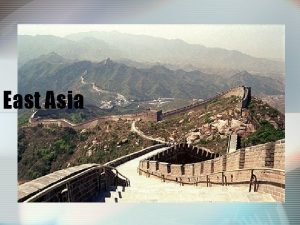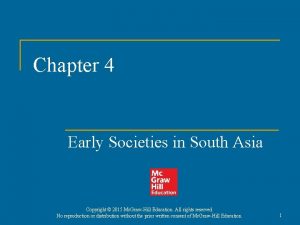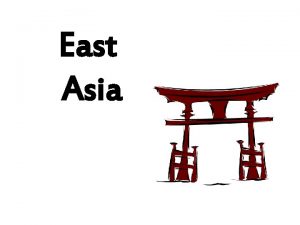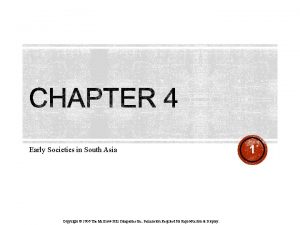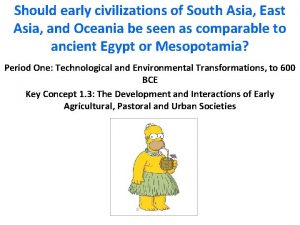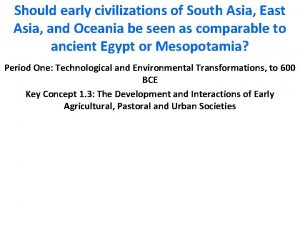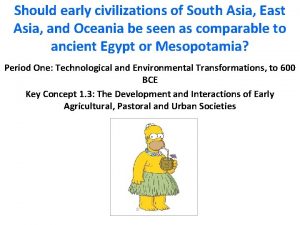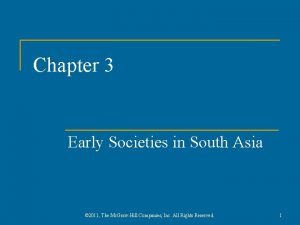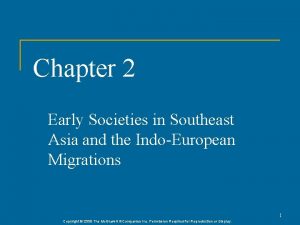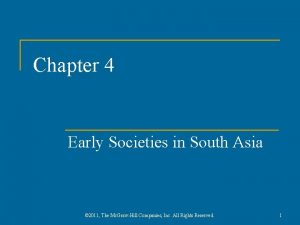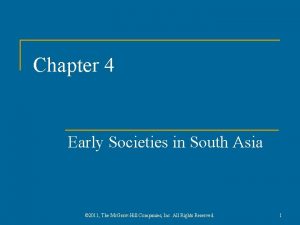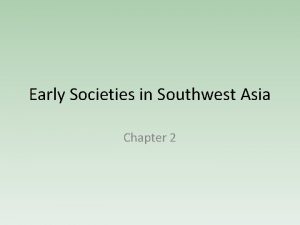Chapter 5 Early Societies East Asia 1 Copyright



























- Slides: 27

Chapter 5 Early Societies East Asia 1 Copyright © 2007 The Mc. Graw-Hill Companies Inc. Permission Required for Reproduction or Display.

Huang He “Yellow” River l l l Loess, extremely fertile China’s Sorrow, devastating floods and changes of course Center of Early Chinese civilization King Yu, dredging and canal work to control the flood effects Develops largely in isolation due to: – Mountains, Deserts, and Seas 2 Copyright © 2007 The Mc. Graw-Hill Companies Inc. Permission Required for Reproduction or Display.

The Earliest Dynasties, 2200 BCE-256 BCE Yellow River: 3000 Miles, Tibet to the Yellow Sea; Deposits fertile, light colored soil; Periodic flooding: “China’s sorrow” l Xia – – – l Shang – – – l Written records and materials Bronze metallurgy Walled cities Zhou – 3 Organized village network Hereditary monarchy Flood control – The mandate of heaven Produced books Copyright © 2007 The Mc. Graw-Hill Companies Inc. Permission Required for Reproduction or Display.

4 Copyright © 2007 The Mc. Graw-Hill Companies Inc. Permission Required for Reproduction or Display.

5 Copyright © 2007 The Mc. Graw-Hill Companies Inc. Permission Required for Reproduction or Display.

6 Copyright © 2007 The Mc. Graw-Hill Companies Inc. Permission Required for Reproduction or Display.

Xia Dynasty l l Thought for a long time to have been a myth Built their cities out of wood and packed earthen works Credited with establishing hereditary monarchical rule in China, effective flood control projects (Yu), and the early development of metallurgy No writing or records 7 Copyright © 2007 The Mc. Graw-Hill Companies Inc. Permission Required for Reproduction or Display.

Shang Dynasty l l l Much more is known about them because they left written records in the form of Oracle Bones Masters of Bronze Metallurgy, of which they kept a guarded monopoly *Chariots from the Indo-Europeans* (what does that mean? ) Shang had a strong centralized rule No formalized law code 8 Copyright © 2007 The Mc. Graw-Hill Companies Inc. Permission Required for Reproduction or Display.

Oracle Bones and Early Chinese Writing l Used for communicating with spirit world, determining future – – l l Question written on animal bones, turtle shells Then heated over fire, cracks examined for omens Early archaeological evidence of Chinese writing Evolution of Chinese script – Pictograph to ideograph, what is the difference? 9 Copyright © 2007 The Mc. Graw-Hill Companies Inc. Permission Required for Reproduction or Display.

Chinese Ideograms l l l The dynamo of the ancient world Effect upon the Chinese people, a unifier Scribes were also the only ones who were taught to write 10 Copyright © 2007 The Mc. Graw-Hill Companies Inc. Permission Required for Reproduction or Display.

Oracle Bone from Shang Dynasty 11 Copyright © 2007 The Mc. Graw-Hill Companies Inc. Permission Required for Reproduction or Display.

12 Copyright © 2007 The Mc. Graw-Hill Companies Inc. Permission Required for Reproduction or Display.

Shang Bronze Amphora 13 Copyright © 2007 The Mc. Graw-Hill Companies Inc. Permission Required for Reproduction or Display.

14 Copyright © 2007 The Mc. Graw-Hill Companies Inc. Permission Required for Reproduction or Display.

Zhou Dynasty l l Slowly overcame the Shang Dynasty Established the Mandate of Heaven – – Family rules because they have the approval of the gods. Dynastic Cycle – Kings could lose the Mandate of Heaven and be overthrown by new kings. 15 Copyright © 2007 The Mc. Graw-Hill Companies Inc. Permission Required for Reproduction or Display.

Zhou Dynasty l l l Decentralized government, feudal in nature Difficulty maintaining their bronze monopoly, why? *Iron is introduced* and this really disrupts the power system in Zhou China 16 Copyright © 2007 The Mc. Graw-Hill Companies Inc. Permission Required for Reproduction or Display.

Zhou Dynasty l l l 17 l The Period of the Warring States result Zhou attacked by nomads, aid was refused from the vassal states, Zhou dynasty moved and the dynasty lost as it’s subordinate states fought amongst themselves for the right to rule At this time three major philosophical traditions of Chinese culture developed - Later Copyright © 2007 The Mc. Graw-Hill Companies Inc. Permission Required for Reproduction or Display.

Southern Expansion of Chinese Society l Yangzi Valley – – – l Yangzi river: Chang Jiang, “long river” Excellent for rice cultivation Irrigation system developed The State of Chu – – Autonomous, challenged Zhou dynasty Culture heavily influenced by Chinese 18 Copyright © 2007 The Mc. Graw-Hill Companies Inc. Permission Required for Reproduction or Display.

Social Order l Ruling classes great advantage – – l l l 19 l Palatial compounds, luxurious lifestyle Supported by agricultural surplus, tax revenues Defended by monopoly on bronze weaponry Hereditary privilege Large class of peasants (high up because they produce food) Support class of artisans, craftsmen Evidence of long-distance trade, merchant class Slave class Copyright © 2007 The Mc. Graw-Hill Companies Inc. Permission Required for Reproduction or Display.

Cultural Beliefs l l l Concept of Tian, was an impersonal power responsible for bestowing or revoking the Mandate of Heaven Not for monitoring or judging personal behavior Polytheistic – l Early gods represented the sun, moon, clouds, and wind No large priestly class develops! 20 Copyright © 2007 The Mc. Graw-Hill Companies Inc. Permission Required for Reproduction or Display.

Family and Patriarchy l l devotion to family, ancestor veneration connection of spirit world to physical world – – l l l 21 Believed the spirit of their ancestors could speak to the gods Ritual sacrifices to gain favor Father ritual head of family rites Earlier prominence of individual female leaders fades in later Shang, Zhou dynasties No formalized religion ever develops, which serves to strengthen what beliefs they already have Copyright © 2007 The Mc. Graw-Hill Companies Inc. Permission Required for Reproduction or Display.

22 Copyright © 2007 The Mc. Graw-Hill Companies Inc. Permission Required for Reproduction or Display.

Family l l Gender, evidence of early matrilineal systems replaced by the Shang times for a patriarchal one Patriarch and extended family possessed tremendous authority over the lives of its members 23 Copyright © 2007 The Mc. Graw-Hill Companies Inc. Permission Required for Reproduction or Display.

Economics l l Trade networks to India as of 2000 b. c. Sail technology, interaction with Korea By the Zhou Dynasty they are using star navigation Crops: soybeans, rice, millet – l l Built irrigation systems Silk, as early as 2600 b. c. e. Domesticated chicken and pigs 24 Copyright © 2007 The Mc. Graw-Hill Companies Inc. Permission Required for Reproduction or Display.

Nomadic Peoples of Central Asia l Steppe nomads – – Poor lands for cultivation, extensive herding activities Horses domesticated c. 4000 BCE, bronze metallurgy in 2900 BCE Extensive trade with sedentary cultures in China l Tensions: l 25 – frequent raiding Copyright © 2007 The Mc. Graw-Hill Companies Inc. Permission Required for Reproduction or Display.

Relationship with Nomads l l Constant interaction Weak China, ominous force Strong China, source of trade and interaction Never adopted Chinese culture, why? 26 Copyright © 2007 The Mc. Graw-Hill Companies Inc. Permission Required for Reproduction or Display.

27 Copyright © 2007 The Mc. Graw-Hill Companies Inc. Permission Required for Reproduction or Display.
 Lesson quiz 11-4 civilizations of east asia
Lesson quiz 11-4 civilizations of east asia China population density
China population density Chapter 27 tradition and change in east asia
Chapter 27 tradition and change in east asia Chapter 27 tradition and change in east asia
Chapter 27 tradition and change in east asia Chapter 26 tradition and change in east asia
Chapter 26 tradition and change in east asia Chapter 14 the resurgence of empire in east asia
Chapter 14 the resurgence of empire in east asia Chapter 27 tradition and change in east asia
Chapter 27 tradition and change in east asia Chapter 15 the resurgence of empire in east asia
Chapter 15 the resurgence of empire in east asia Chapter 15 the resurgence of empire in east asia
Chapter 15 the resurgence of empire in east asia Chapter 14 the resurgence of empire in east asia
Chapter 14 the resurgence of empire in east asia The resurgence of empire in east asia
The resurgence of empire in east asia Monotheism
Monotheism Is middle east in asia
Is middle east in asia Oceania 1984 map
Oceania 1984 map Asia geography
Asia geography Physical geography east asia
Physical geography east asia Mon khmer
Mon khmer Physical geography of east asia
Physical geography of east asia The commander of the german east asia squadron was
The commander of the german east asia squadron was Ming china spice chart
Ming china spice chart East asia sushi
East asia sushi Easc usc
Easc usc East asia
East asia Lesson 8 middle east and south asia
Lesson 8 middle east and south asia Southern & eastern asia physical features map
Southern & eastern asia physical features map Post classical vietnam
Post classical vietnam Horizontal movement of air is called
Horizontal movement of air is called Kalahari desert on africa map
Kalahari desert on africa map
